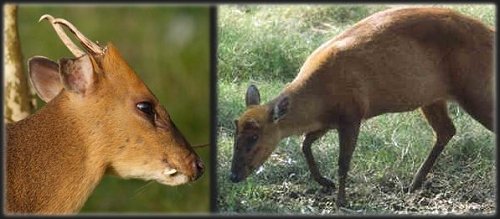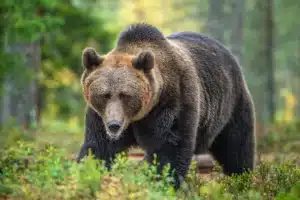Muntjac deer fact file

The
Muntjac deer fact file
The Muntjac Deer
Common name – Muntjac deer (often called Reeves Muntjac)
Scientific name – muntiacus reevesi
Size – smallest of all UK deer, adults stand approximately 45cm at the shoulder and have an average weight range of between 10 – 16kg. The males (bucks) are marginally larger than the females (does).

Identification tips – a Muntjac’s small size is the primary factor in identification, and they often appear to be hunched forward when running. During the summer months a Muntjac’s coat is a uniform reddy-brown colour with very pale, often white, hair under the chin, throat, belly and tail. The tail itself is a good identification aid, being noticeably longer than the tails of other British deer.
Muntjac bucks have small and unbranched antlers which slope rearwards, ending in a pointed tip. They also have elongated canine teeth which can appear as small tusks protruding downwards from the upper lip.
Preferred habitat – Muntjac deer favour wooded areas, the denser the vegetation the better.
Diet – most forest foods will be eaten; fresh tree shoots, leaves, nuts, berries, acorns and fungi are all part of a Muntjac’s diet. They will also strip bark from the bottom of trees. The deer typically feed at 3 – 4 hourly intervals, consuming fresh food quickly and then retreating into the undergrowth to chew the cud.
Breeding – Muntjac deer can mate at any time of the year, there is no particular season as there is for the other British deer species. A single kid is produced 7 months after mating happens. Having given birth, the doe is in season again after a very short time and the kid is weaned after 6 – 8 weeks, and is totally independent of the mother by 6 months.
Other points – Muntjac deer originate from China and were introduced into Britain in the late 19th century. London zoo and Woburn Park in Bedfordshire were their initial place of captivity but escaped Muntjacs from Woburn have led to the British population.
The Muntjac deer of the New Forest are very few in number and extremely hard to find, not only because of their tiny size but mainly because of their preference to staying in densely wooded areas.
Despite their size, they are one of the most audible deer and can bark loudly for up to 20 minutes in an effort to find a mate.
Related Sites

Rugged Looks Built for Park Terrain
Whether you’re driving winding forest roads or parked at a trailhead surrounded by mossy oaks and chirping robins, your truck says a lot about your adventure style. For many outdoor enthusiasts, function comes first—but that

Planning Safe Camps
Setting up camp in remote locations is the kind of adventure many dream about—off the grid, fresh air, starry skies. But anyone who’s tried it knows there’s a fine line between a fun escape and

How to Find the Most Beautiful Secret Hotels
If you’re craving a luxurious, quiet retreat away from the hustle and bustle, a secret hotel might be the getaway you need. You can check into a hidden spot in an atmospheric city, a gorgeous

The Most Thrilling Shore Excursions
Do you want to know about the most thrilling shore excursions? If you’re after an action-packed escape on the British coast, New Forest National Park really does deliver some of the wildest shore excursions for

Explore the Wildlife in the UK
Great Britain is renowned for its architectural, historical, and cultural attractions. However, when it comes to natural rarities, many of us do not consider this country first, but neighboring Scotland and Wales. This is, in

Most Visited Tourist Attractions in UK
The UK has a variety of world-renowned attractions. These range from museums to historic landmarks, and include natural wonders as well. This list includes some of the UK’s most popular tourist attractions, which attract millions of
